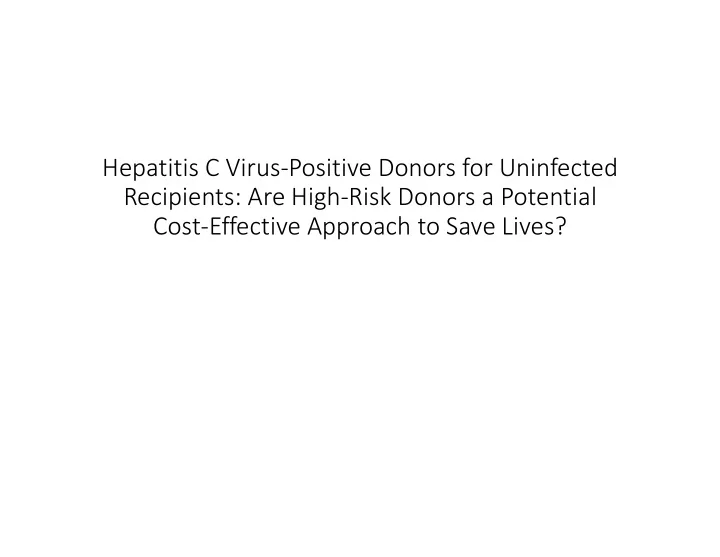

Hepatitis C Virus‐Positive Donors for Uninfected Recipients: Are High‐Risk Donors a Potential Cost‐Effective Approach to Save Lives?
Familial cardiomyopathy Listed for urgent heart transplant Received heart from IV drug abuser who was HCV positive. Treated for HCV immediately after the operation, cleared the virus.
Growth in HCV Positive Organs to HCV Negative Recipients. • In 2014 there were only 600 hepatitis C‐positive transplants, and 44 went to patients without hepatitis C. • In the first 10 months of 2018 there were 1,631 hepatitis C‐positive organ transplants. 1,058 were for patients without hepatitis C.
Transplantation of HCV–positive organs into HCV–negative recipients. Hepatology, Volume: 67, Issue: 4, Pages: 1600-1608, First published: 10 October 2017, DOI: (10.1002/hep.29572)
Pretransplant mortality rates among adults waitlisted for kidney transplant by age. OPTN/SRTR 2016 Annual Data Report: Kidney American Journal of Transplantation, Volume: 18, Issue: S1, Pages: 18-113, First published: 02 January 2018, DOI: (10.1111/ajt.14557)
Pre-transplant mortality rates among adults waitlisted for kidney transplant in 2016, by DSA. American Journal of Transplantation, Volume: 18, Issue: S1, Pages: 18-113, First published: 02 January 2018, DOI: (10.1111/ajt.14557) OPTN/SRTR 2016 Annual Data Report: Kidney
Age-adjusted drug overdose death rates: United States, 1999–2017
3,500 3,000 Number of cases 2,500 2,000 1,500 1,000 500 0 Year Source: CDC, National Notifiable Diseases Surveillance System (NNDSS)
Drug overdose death rates, by selected age group: United States, 1999–2017
Overall graft survival (in years) by the Kaplan - Meier method for HCV uninfected adult DDKT recipients of HCV seropositive, non-viremic donors vs HCV uninfected donors. . Overall graft survival (in years) by the Kaplan - Meier method for HCV uninfected adult DDKT recipients of HCV viremic donors vs HCV uninfected donors. American Journal of Transplantation, First published: 17 June 2019, DOI: (10.1111/ajt.15496)
Plot of cost and effectiveness in QALYs of using hepatitis C PCR‐positive transplant compared with remaining on the waitlist for 1, 2, 3, 4, and 5 additional years. The lines between 1 Year Waitlist and Hepatitis C Transplant points demonstrate the incremental cost‐effectiveness ratio of using a HCV NAT‐positive kidney for transplant compared to remaining on the waitlist for 1 additional year American Journal of Transplantation, Volume: 18, Issue: 10, Pages: 2457-2464, First published: 23 May 2018, DOI: (10.1111/ajt.14929)
HCV Positive Recipients Shorter Wait Times and Better Grafts • Recipients of HCV(+) kidneys waited 395 days less than their counterparts at the same center who waited for HCV(‐) kidneys • The median time from eligibility on the waiting list for hepatitis C– infected kidneys to transplantation was 58 days (interquartile range, 53 to 100). • The median Kidney Donor Profile Index score (on a scale from 0 to 100%, with higher values indicating a greater risk of graft failure for an individual kidney) was 42% • The median wait time for a transplant is 11 days among patients who have consented to hearts from hepatitis C‐positive donors
HCV Positive Donors in Liver Transplantation • Patients receiving HCV‐positive livers were treated with DAA therapy for 12 weeks. They demonstrated that willingness to accept HCV‐ negative or viremic livers resulted in an increase in patients’ life expectancy when the MELD was ≥ 20.
What about HCV NAT/RNA Negative Donors? • One recent report however described transmission of HCV to 4 of 24 (16%) liver recipients from HCV Ab+/RNA‐negative donors. • Although the reasons for this have yet to be fully elucidated, all were considered “increased risk donors” and this may have represented a local outbreak of HCV re‐infection and donors in the eclipse phase of this re‐infection. • HCV RNA should be tested at 30 days after transplantation
How to Clear the HCV After Transplantation? • Glecaprevir/pibrentasvir for 12 weeks in 20 kidney transplant recipients was well tolerated with an SVR of 98%. • 114 kidney transplant recipients with either genotype 1 or 4 HCV infection randomized to receive ledipasvir/sofosbuvir for 12 or 24 weeks, all patients achieved SVR and treatment was well tolerated.
Interactions with Immunosuppressive agents. • Co‐administration of glecaprevir/pibrentasvir with CyA requires close monitoring as concentrations of glecaprevir/pibrentasvir may increase • This protease inhibitor should be avoided in those requiring a daily dose of CyA of more than 100 mg.
Summary • Patients awaiting transplantation of thoracic and abdominal organs have a significant risk of dying on the waiting list. • The opioid epidemic has led to a marked increase in the number of HCV positive donors. • Donors that are HCV RNA/NAT positive can transmit HCV so that a recipient of these organs most likely will be infected from the donor organ. HCV antibody positive and NAT negative donors may transmit HCV. • Treatment of the transmitted HCV after transplantation appear to be effective and tacrolimus doesn’t appear to have significant interactions.
Recommend
More recommend